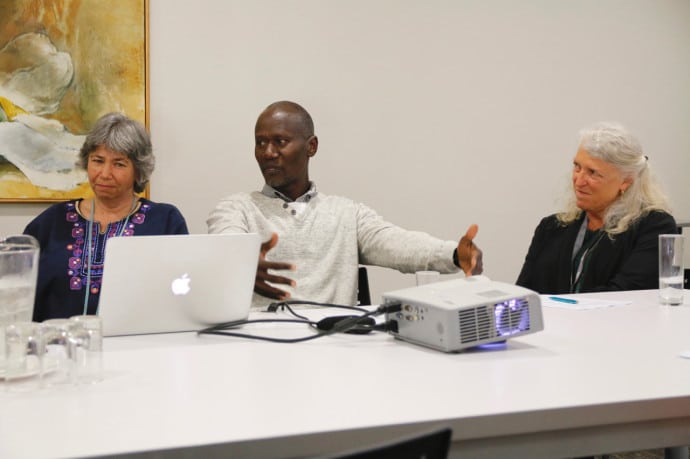“We are asking what the arts can teach us to help us transform to a more liveable world,” said Michelle LeBaron of the Peter A. Allard School of Law at the University of British Columbia. “Our work is about the role of art in transforming conflict. Art is a powerful way of supporting wellbeing and belonging and our progress as humans. We are asking what we can do now to live more constructively together across differences.”
LeBaron and her colleagues Kim Berman of the Department of Visual Art at the University of Johannesburg and Kitche Magak of the Department of Literary Studies at Maseno University in Kenya presented a seminar on their STIAS project Theory and practice of social transformation through the arts which is part of the Being Human Today STIAS long-term theme.

Their presentation featured their forthcoming book Changing Our Worlds: Art as Transformative Practice, which examines the nexus between the arts and values-informed social transformation.
“The book explores how art—whether compelling, disturbing or beautiful—has the power to transform both the individual and the collective in the direction of social justice,” said LeBaron. “Through examples of arts in a range of settings from communities to the South African Constitutional Court, we link theory and practice on how arts processes can transform structures and social relationships toward equality.”
The book examines these issues through three theoretical lenses – democratic engagement, coloniality and cultural fluency – all three linked to the emergence of a scholarly field of socially transformative arts.
This unique project blends South African, Kenyan, Rwandan, American and Canadian scholarship, creative work and traditional wisdom on how the arts have advanced social justice and the best ways to gauge future progress and success. Informed by fieldwork in diverse countries, the authors describe how arts can strengthen communities, smoothing fault lines and addressing inequities while offering ways to express unspeakable truths and foster resilience.
The group convened an Arts and Social Transformation Colloquium at STIAS from 30 April – 3 May 2018 co-hosted by the Peter Wall Institute for Advanced Studies at UBC and STIAS. This second colloquium included nearly two dozen international scholars who attended a colloquium on the same subject in 2015, along with several South African scholars and artists.
“Art is present in all communities,” said Magak, “and transformative art practices function in all societies whether we are conscious of them or not. Part of our work is bringing what is unseen into visibility so that more conscious choices can be made.”
Looking specifically at the works of some South African artists of various genres including Dennis Brutus, Hugh Masekela, Alex La Guma, Miriam Makeba, Jonny Clegg and Andre Brink, Magak pointed out that: “Art in South Africa continues to engage with injustice. Apartheid may have ended but the work of the artist doesn’t end – it continues.”
“We want to ask what art is and what it is doing for social transformation,” he continued. “Transformative art is ultimately about humanising our existence.”
Measuring the impact
But it is also important that we don’t make assumptions about the efficacy of art, and that evaluation methods are developed to measure specific ways that art is transformative. Kim Berman discussed the importance of evaluating arts-based practices in ways that take their lead from communities. She emphasised that traditional arms-length methods and expert-centred approaches do not adequately capture arts’ potentials.
“Traditional evaluation models tend to render judgements on worth and outcomes. Evaluation like this can break down people’s spirits and destroy potential rather than enhance it. For vulnerable communities, evaluation can be terrifying,” she said. “Imposing values from outside can deepen clashes between communities and funders and may be seen as patronising.”
“We strive for evaluation that creates and deepens understanding – that enhances and encourages rather than dampens. Evaluation needs to also embody the values and ethics of social justice and to fully acknowledge art as source of healing and empowerment.”
In discussion with STIAS scholars, Berman also pointed out that, ideally, artists should have integral roles in community development initiatives – working across and alongside those from other disciplines to contribute to change. Community initiatives will be more likely to be durable if local people feel like respected partners.
Berman also addressed the role of artists and artists’ voices in transformative processes, specifically addressing the recent defacing of artworks in the South African student protests. She posed these questions: “Does the artist have an ongoing voice in how transformative the art is? And, importantly, do they have the last voice?”
In answer, Berman quoted from Chief Justice Arthur Chaskalson at artist Judith Mason’s retrospective exhibition: ‘A work of art, once completed, takes on a life of its own. It has been created for others to see. What they see may not be what the artist intended… At best an artist starts a conversation and has no control over how it develops, but imagery needs to be read aright in order for the conversation to develop at all’ (in Mason J. Unstitching the Blue dress: A response, 2017).
Berman continued: “It’s been an unsettling time on all levels for South African universities. Healthy dissent is a way of unsettling the status quo and making necessary shifts. But ongoing engagement and negotiation are important to sustain change processes.”
“We live in violent societies,” added LeBaron. “Often, we may have ideal outcomes in mind, but not necessarily how to achieve them. We need to understand how arts processes can be part of sustaining powerful citizen action. Art helps us to understand a spectrum of ways of seeing issues and allows us to find connections. It can help us express feelings beyond words and rational analysis – involving our bodies, our senses, and our emotional intelligence. Art helps us dialogue after trauma, and shows us ways through crises that are not obvious, but emergent.”
Michelle Galloway: Part-time media officer at STIAS
Photograph: Christoff Pauw
